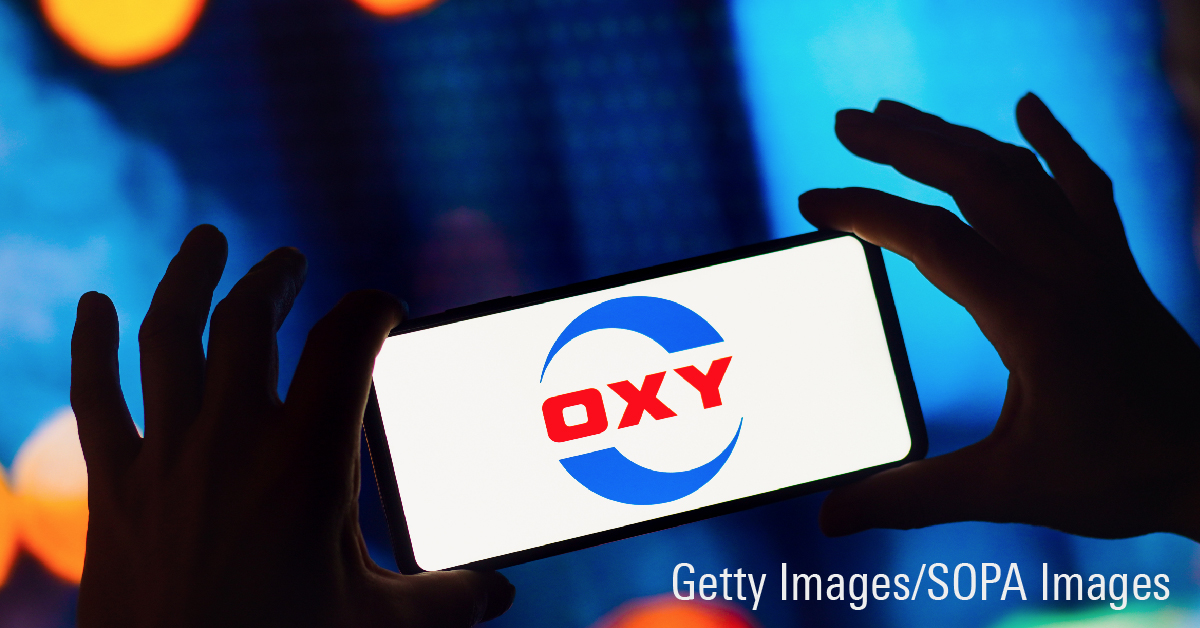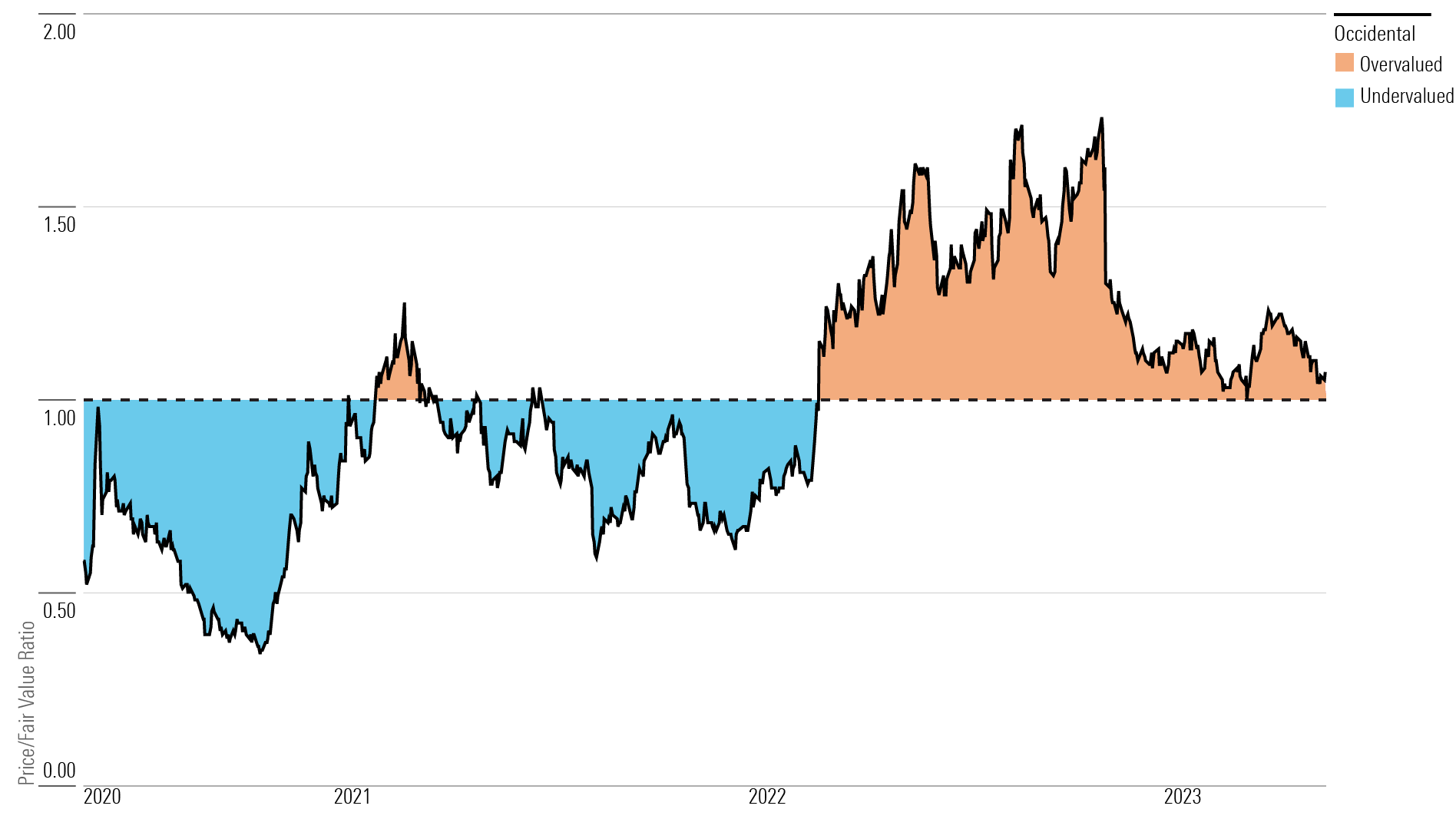Is Occidental a Buy, a Sell, or Fairly Valued After Earnings?
With an improved long-term outlook, here’s what we think of Occidental’s stock.

Occidental Petroleum OXY released its first-quarter earnings report on May 10. Here’s Morningstar’s take on what to think of Occidental’s earnings and stock.
Occidental Stock at a Glance
- Fair Value Estimate: $56
- Morningstar Rating: 3 stars
- Morningstar Economic Moat Rating: None
- Morningstar Uncertainty Rating: Very High
What We Thought of Occidental’s Earnings
We slightly raised our fair value estimate for Occidental after incorporating its earnings. The near-term outlook for the chemical business is better than expected—caustic soda and PVC prices are holding up better than anticipated. The oil and gas production outperformance gives us confidence that the firm can hit raised full-year guidance without busting the unchanged budget. Some of the reported outperformance was related to maintenance timing and accounting, which won’t affect the thesis. Even after adjusting for those issues, the firm delivered more oil and gas than expected, demonstrating the productive potential of its assets, especially in the Permian Basin and the Rockies.
Meanwhile, a decline in near-term commodity prices resulted in weak financial results, but management’s explanation for why that shouldn’t affect future quarters was credible: Downstream capacity issues in the highly seasonal Gulf of Mexico and third-party processing outages in the Rockies both sound like one-time issues. The overall long-term thesis improved a little, but the stock is pretty close to fairly valued.
Our fair value estimate is based on a long-term average of $55 West Texas Intermediate/$60 Brent, which is probably a little more bearish than the market. If we incorporated higher prices, the stock would look more attractive. We acknowledge that the near-term outlook is constructive because demand growth will probably outpace supply this year, barring a recession (because swing producers OPEC and the United States have limited incremental capacity, and neither group wants to ramp up production anyway), and that’s what the market has been focusing on. But the marginal cost of supply is much lower than the spot price, so producers have an incentive to bring new supply online, and that should bring the market into balance over the cycle, resulting in lower prices.
Occidental Stock Price

Fair Value Estimate for Occidental Stock
Our primary valuation tool is our forecast of net asset value. This bottom-up model projects cash flows from future drilling on a single-well basis and aggregates across the company’s inventory, discounting at the corporate weighted average cost of capital. Cash flows from current (base) production are included with a hyperbolic decline rate assumption. Our valuation also includes the mark-to-market present value of the company’s hedging program.
Based on this methodology, our fair value estimate for Occidental stock is $56 per share. This corresponds to enterprise value/EBITDA multiples of 5.3 times for 2023 and 4.8 times for 2024. Our production forecast for 2023 is 1.19 million barrels of oil equivalent per day, which is consistent with guidance.
Read more about Occidental’s fair value estimate.
Occidental Price/Fair Value Ratio

Economic Moat Rating
The upstream oil and gas industry recently realized that investors are more interested in consistent and stable returns than breakneck production growth. Most firms are now committed to conservative capital programs with low reinvestment rates and generous shareholder distributions. But a handful of producers were doing this long before the rest of the industry hopped on the bandwagon, and Occidental was one of them. Like its peers, the firm eventually adapted to lower prices by improving efficiency and using new technology to reduce costs. But just when profitability was recovering, Occidental jumped into a very large and expensive corporate acquisition in 2019, which took several years to digest. The target, Anadarko Petroleum, did not itself warrant a moat rating, and Occidental paid a substantial takeover premium. The most significant environmental, social, and governance exposures are greenhouse gas and other emissions, effluents, and waste. Occidental has credibly positioned itself as a net-zero champion within the industry, and its Low Carbon Ventures unit has ambitious plans to construct 70-135 direct air capture plants in the areas in which it operates.
Read more about Occidental’s moat rating.
Risk and Uncertainty
As with most exploration and production firms, a deteriorating outlook for oil and natural gas prices would pressure Occidental’s profitability, reduce cash flows, and drive up financial leverage. An increase in federal taxes or a revocation of the intangible drilling deduction U.S. firms enjoy could also affect profitability and reduce our fair value estimate. Material ESG exposures create additional risk for E&P investors. Climate concerns could also trigger regulatory interventions such as fracking bans, drilling permit suspensions, and perhaps even direct taxes on carbon emissions. The firm’s drilling campaign in the Gulf of Mexico requires ongoing approvals from the U.S. Department of the Interior. As this entity is controlled by the executive branch, it can suspend permitting activity without congressional approval.
Read more about Occidental’s risk and uncertainty.
OXY Stock Bulls Say
- Occidental has a dominant position in the Permian Basin, which is the cheapest source of production in the U.S. and is expected to be a major growth engine in the next few years.
- Occidental’s conventional assets in the Gulf of Mexico and the Middle East complement its shale operations nicely by generating stable cash flows from assets with a much lower base decline rate.
- The Low Carbon Ventures unit is synergistic with Occidental’s chemical business, and the company’s enhanced oil recovery portfolio holdings and expertise give it a natural advantage in carbon capture.
OXY Stock Bears Say
- Though Occidental’s Permian wells exhibit very high initial production rates, they also decline very quickly.
- The Anadarko acquisition bolstered Occidental’s Permian footprint but left it with other assets it didn’t really want, such as its Western Midstream WES stake and its North Africa operations.
- Occidental will have to share the spoils of its ambitious carbon capture plans, and since it isn’t providing financing or engineering, it will have to give away a sizable working interest.
This article was compiled by Maggie Guidici.
Get access to full Morningstar stock analyst reports, along with data and tools to manage your portfolio, through Morningstar Investor. Learn more and start a seven-day free trial today.
The author or authors do not own shares in any securities mentioned in this article. Find out about Morningstar’s editorial policies.

/s3.amazonaws.com/arc-authors/morningstar/17f48ad3-acb4-4abc-982b-fb3b14ceda2f.jpg)
/cloudfront-us-east-1.images.arcpublishing.com/morningstar/RZEYRM7QNVE63FSD5LZOBHHTTQ.jpg)
/cloudfront-us-east-1.images.arcpublishing.com/morningstar/AET2BGC3RFCFRD4YOXDBBVVYS4.jpg)
/cloudfront-us-east-1.images.arcpublishing.com/morningstar/IORW4DN3VVC3BC4JO7AQLSJTF4.jpg)
:quality(80)/s3.amazonaws.com/arc-authors/morningstar/17f48ad3-acb4-4abc-982b-fb3b14ceda2f.jpg)